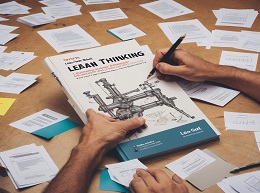Lean Thinking

"Lean Thinking" by James P. Womack and Daniel T. Jones is a groundbreaking book that revolutionized the way organizations approach efficiency and productivity. Drawing on principles derived from the Toyota Production System, the authors introduce the concept of lean thinking, which emphasizes eliminating waste, improving flow, and maximizing value for customers. In this comprehensive review, we'll explore the key concepts of "Lean Thinking," share compelling examples, and provide actionable insights for implementing lean principles in your organization.
Understanding the Principles of Lean Thinking:
Womack and Jones outline the five core principles of lean thinking: value, value stream, flow, pull, and perfection.
Example:
Toyota's approach to lean manufacturing, known as the Toyota Production System (TPS), exemplifies the application of lean principles to achieve efficiency and quality in production processes.
Eliminating Waste:
The authors highlight the importance of identifying and eliminating waste in all its forms, including overproduction, waiting, unnecessary transportation, excess inventory, defects, and underutilized talent.
Example:
Amazon's use of Just-In-Time (JIT) inventory management minimizes excess inventory, reduces storage costs, and ensures that products are delivered to customers in the shortest possible time frame.
Creating Value for Customers:
Lean thinking emphasizes the importance of focusing on activities that add value to the customer while eliminating those that do not.
Example:
Zappos' commitment to delivering exceptional customer service, including free shipping and hassle-free returns, has earned the company a loyal customer base and differentiated it from competitors.
Achieving Flow and Pull:
The authors discuss the concepts of flow, which involves smoothing the production process to eliminate bottlenecks, and pull, which involves producing goods or services in response to customer demand.
Example:
Tesla's production system is designed to achieve a smooth flow of materials and components on the assembly line, with each workstation producing only what is needed by the next workstation, based on customer demand.
Pursuing Continuous Improvement:
Lean thinking is synonymous with continuous improvement, as organizations strive to identify and implement incremental changes to optimize processes and enhance value for customers.
Example:
Toyota's practice of kaizen, or continuous improvement, encourages employees at all levels to identify opportunities for improvement and implement small changes to streamline processes and eliminate waste.
In conclusion, "Lean Thinking" offers a comprehensive framework for organizations seeking to achieve greater efficiency, quality, and customer satisfaction. By embracing the principles of lean thinking and learning from real-world examples, organizations can optimize their processes, reduce waste, and drive continuous improvement to achieve sustainable success.













